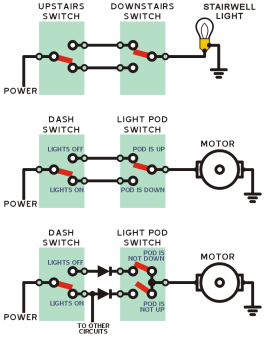 The first circuit is shown at the left. It is a common 'two-way' light switch circuit that is used in stairwells and hallways. The light can be turned on or off from either switch. The first circuit is shown at the left. It is a common 'two-way' light switch circuit that is used in stairwells and hallways. The light can be turned on or off from either switch.
To reengineer the circuit for pod control, replace the light bulb with a motor. The 'upstairs' switch becomes part of the main lighting switch on the Wedge dash. The 'downstairs' switch is inside the headlight pod and gets flipped one way when the pod reaches full up and the other way when it reaches full down.
Turn the dash switch 'ON' and the motor runs, raising the headlight until the pod switch flips and turns it off. Turn the dash switch 'OFF' and the motor runs, lowering the headlight until the pod switch flips the other way and turns it off again.
(The actual circuit is a little more complicated. Some diodes are added to keep the signal from feeding back into places it doesn't belong under certain conditions. The switch inside the headlight pod doesn't actually flip, but is really two pushbutton switches that together behave like a slide switch with a make-before-break action. The final two diagrams on this page depict the sequence more clearly.)
|
 The pod motors must stop accurately when the pods reach their raised positions to correctly aim the headlights, so they use electrical braking in addition to 'hard' stops. The same circuit is commonly employed by power tools and electric lawnmowers to stop the blade quickly when switched off. The pod motors must stop accurately when the pods reach their raised positions to correctly aim the headlights, so they use electrical braking in addition to 'hard' stops. The same circuit is commonly employed by power tools and electric lawnmowers to stop the blade quickly when switched off.
You may have noticed that unplugging a power saw while keeping the trigger depressed will allow it to spin down slowly, while releasing the trigger will cause it to stop almost instantly. That's because the trigger switch shorts the motor's power leads together after it disconnects them from the incoming power line.
When a motor is turned by its shaft (or inertia) instead of by its windings, it acts as a generator. The greater the electrical load on a generator, the more difficult the shaft is to turn. If the generator is trying to feed power into a dead short, it is very hard to turn, indeed. The motor/generator stops extremely quickly instead of coasting down. Most cars' windshield wiper circuits also use this technique to park properly.
The Wedge headlight circuit uses a pair of relays located near the fuse block behind the glove box to start and stop the pod motors. Located nearby is a single auto-reset circuit breaker that protects both relays and pod motors. If the circuit breaker is going bad, it may start getting tripped by normal amounts of current instead of overloads. The pods will randomly stop then start up again a moment later. If the ground circuit connected to the relay contacts becomes bad, the pods will raise and lower but they will not stop where they should, and may just keep going up and down. Corrosion in the various electrical connectors seems to be the main cause for failure, but watch out for bad gaskets letting water into the limit switch housings on the motor assemblies, too.
The Repair Operation Manual has detailed instructions for repairing and adjusting the headlight assemblies. When looking for spares and information, be aware that the first generation Lotus Esprit used the exact same mechanisms with different pods attached. |
